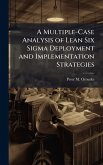This research investigated value and utility functions in multiobjective decision analysis to examine the relationship between them in a military decision making context. New data is presented and data from an earlier study is also analyzed for this relationship. Further, the impact of these differences on the decision model was examined in order to improve implementation efficiency. Specifically, the robustness of the decision model was examined with respect to the preference functions to reduce the time burden imposed on the decision maker. Data for decision making in a military context supports the distinction between value and utility functions. Relationships between value and utility functions and risk attitudes were found to be complex. Elicitation error was significantly smaller than the difference between value and utility functions. Risk attitudes were generally neither constant across the domain of the evaluation measure nor consistent between evaluation measures. An improved measure of differences between preference functions, the weighted root means square, is introduced and a goodness of fit criterion established. An improved measure of risk attitudes employing utility functions is developed. Response Surface Methodology was applied to improve the efficiency of decision analysis utility model applications through establishing the robustness of decision models to the preference functions. Which value-utility differences are significant was determined. An algorithm was developed and employs this information to provide a hybrid value-utility model that offers increased elicitation efficiency for the decision maker. This work has been selected by scholars as being culturally important, and is part of the knowledge base of civilization as we know it. This work was reproduced from the original artifact, and remains as true to the original work as possible. Therefore, you will see the original copyright references, library stamps (as most of these works have been housed in our most important libraries around the world), and other notations in the work. This work is in the public domain in the United States of America, and possibly other nations. Within the United States, you may freely copy and distribute this work, as no entity (individual or corporate) has a copyright on the body of the work. As a reproduction of a historical artifact, this work may contain missing or blurred pages, poor pictures, errant marks, etc. Scholars believe, and we concur, that this work is important enough to be preserved, reproduced, and made generally available to the public. We appreciate your support of the preservation process, and thank you for being an important part of keeping this knowledge alive and relevant.
Bitte wählen Sie Ihr Anliegen aus.
Rechnungen
Retourenschein anfordern
Bestellstatus
Storno








